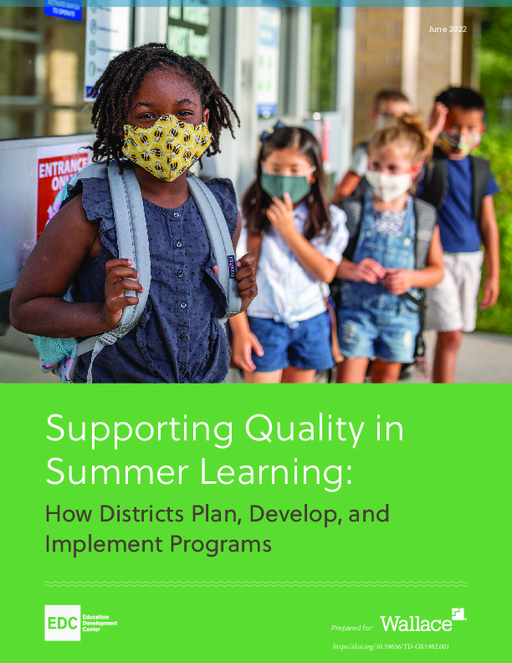- Author(s)
- Leslie Goodyear, Tony Streit, Alyssa Na’im, Katrina Bledsoe, Meghan Broadstone, Katari Coleman, Sara Greller, Tracy McMahon, Sheila Rodriguez, Heidi Rosenberg, and Salma Shawa
- Publisher(s)
- Education Development Center, Inc.
Research Approach
This study focused on programs run by urban school districts, including those programs implemented in partnership with community—or youth-serving organizations. The authors also included how district leaders incorporate parents’ priorities into the design and implementation of summer learning programs. With districts at the center of our inquiry, they identified three additional main sources to understand the systems of support for, and decision-making about, high-quality summer learning for school districts:
- 21st Century Community Learning Centers (21st CCLC): The researchers investigated the ways in which district-led summer learning programming is funded and supported by states’ 21st CCLC programs, including related summer program requirements for subgrantees and state-led professional learning opportunities. The 21st CCLC program is a federally funded OST program that is administered by state-level staff (typically within a state’s department of education) and implemented at the local level (usually at a school or community-based organization [CBO]). Including 21st CCLCs in their inquiry into district-led summer programs was critical to understanding this distinct intersection of federal, state, and local supports for summer learning.
- State resources and supports: The authors examined policies and practices in a select group of states to understand the extent to which state-level coordination, funding, and other resources exist and offer support for district-led summer learning programs. Because districts are both constrained and supported by state-level policies and resources, this aspect of the research helped to clarify and deepen their understanding of the issues influencing district-level decision-making about summer programs, related professional development (PD), funding, and other supports.
- Federal funding streams: In addition to the 21st CCLC program, the authors documented three other major traditional federal funding streams for summer learning, as well as more recent supplemental funding sources. Federal funding sources are relevant in as much as they provide guidance to and support for district-level decision-making about summer learning programs. The COVID-19 pandemic compelled them to modify the overall approach to the study. The study shifted from one focused on a snapshot in time to one focused on capturing the changing state of support for summer learning and the lessons resulting from the impact of the COVID-19 pandemic.
Their inquiry was guided by the following research questions that sought to capture insights relevant across three different time periods (the summers of 2019, 2020, and 2021), as well overarching insights that span the time frame and beyond.
- What district-level policies and practices inform the planning, development, and implementation of publicly funded summer learning programs serving K–8-aged youth?
- Other than funding, what external supports (e.g., professional development, resources, and tools) are being used to implement or strengthen such summer learning programs?
- What do district stakeholders perceive as key needs, gaps, and opportunities regarding improving summer learning programs?
- What do families look for in a summer learning program, and how do they access the right program for them?
The researchers used a combination of secondary research, or what they called foundational research, along with primary research to address the above research questions. The foundational research included a review of online resources and relevant literature, which informed their understanding of the articulated needs, gaps, and issues facing summer learning programs. The primary research involved obtaining, through interviews and a survey, multiple perspectives from district representatives and community partners (representing 38 districts in 30 states); staff from 21st CCLC state offices (25 states); and other state-level stakeholders (5 states) involved in the design, implementation, and funding of district-led summer learning programs. Initially, we planned two rounds of primary data collection with district contacts, 21st CCLC state leads, and other state-level respondents in fall 2020 and in spring 2021.
As districts made decisions about remote, hybrid, or in-person learning, many district staff simply did not have the time or attention to devote to their requests. As a result, they decided to conduct one extended round of data collection starting in October 2020 and continuing through early May 2021 Overall, they gathered perspectives from 92 individuals involved in the design and implementation of summer programs at the district, community, and state levels.

